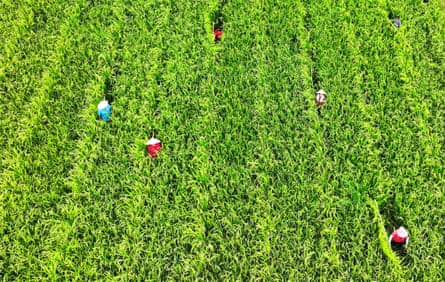The Impact of Insect Extinction on Our Planet’s Food, Soil, and Water
C
When an apple is sliced in half, the pale flesh exposes a group of dark seeds forming a star-shaped pattern. This small arrangement of seeds is tucked away within the fruit, yet it represents a complex network of pollination and natural riches. However, this delicate system can easily be disrupted.
After the apple flowers are fertilized, hormones are released from the seeds to signal the plant to produce the necessary nutrients, minerals, and growth rate. These hormones play a role in determining the crispness, size, and shape of the apple. Without pollinators, this delicate system becomes unstable. If only a few seeds are pollinated, the apple may develop unevenly. This could result in a decrease in nutritional value and a shorter shelf-life, causing the fruit to turn brown and shrivel prematurely.
The tale of the apple has been repeatedly told around the globe. A recent study cautions that approximately two million species are in danger of disappearing, twice the number previously estimated by the UN. This rise is attributed to improved information on insect populations, which have been less comprehensively studied compared to other species.
Frequently, it is creatures such as bugs – the types we typically disregard – that offer the most benefits to human communities: aiding in crop pollination, contributing to nutrient-rich soil, and managing pest populations.
Although there are still uncertainties surrounding invertebrates, there is clear evidence of a significant decline in wildlife worldwide. Over the past five decades, there has been an average decrease of 70% in wildlife populations, which is already having an impact on human societies and their ability to function and sustain themselves.
What is occurring with pollination?
A recent research report suggests that 24% of invertebrates, which are crucial for pollination, are in danger of becoming extinct.
Plants that are rich in essential nutrients, such as fruits, vegetables, and nuts, rely on pollinators and soil organisms to maintain their fertility. Pollinators are responsible for pollinating 75% of our food crops, and the soil contributes to 95% of our food supply either directly or indirectly.
According to Professor Simon Potts of Reading University, a decrease in pollination results in lower production and reduced quality of the crops. This can lead to misshapen strawberries with lower sugar content.
He states that we refer to this as a “pollination deficit”.

A study in Nature Communications examined 48 crops from 48 countries and found that fruits pollinated by animals and insects had an average quality improvement of 23% compared to those not pollinated by animals. This was particularly evident in the shape, size, and shelf-life of the produce.
Researchers caution that cultivating fruit that has a short lifespan and unusual appearance may lead to a rise in food waste, affecting the entire production process.
How does this impact our global food system?
Pollination by insects adds over £600 million annually to the UK’s economy. Potts believes that biodiversity should be recognized as a valid agricultural input. While farmers typically oversee water, fertilizers, pesticides, and seeds, not many prioritize managing biodiversity as an input.
According to a study conducted by Harvard University and published in the journal Environmental Health Perspectives, approximately 3-5% of global vegetable, fruit, and nut production is being lost due to inadequate pollination.
The main scientist, Matthew Smith, who focuses on environmental health, expressed surprise at the initial appearance of the figure being relatively small.

The impact of this loss, which amounts to 3-5%, is noteworthy. Researchers discovered that it results in roughly 420,000 additional deaths each year due to decreased intake of nutritious food and related illnesses.
Smith states that the number is comparable to the annual deaths caused by substance-use disorders, interpersonal violence, or prostate cancer.
The financial impact of these losses can be significant as well. According to a study, a lack of pollination for the UK’s Gala apple harvest could result in a production loss of £5.7m.
Smith and their team simulated the equivalent loss of economic value in agricultural production for three countries: Honduras, Nigeria, and Nepal. They discovered that between 16% and 31% of the economic value from agriculture was lost due to insufficient pollination.
“They say this has a significant and widespread impact since a large portion, approximately one- to two-thirds, of the population in these countries work in the agricultural sector.”
What about water?
Pollinators help provide clean water and sanitation because healthy plant ecosystems keep waterways clean. Mangroves, which benefit from animal pollination, filter out pollutants, absorb runoff and encourage sedimentation, all of which help improve water quality. Since the end of the 1990s, global mangrove cover has declined by roughly 35%.
According to a study in the journal Nature, environments with a greater variety of species have a higher capacity to eliminate pollutants, leading to improved water quality. Studies indicate that freshwater ecosystems are experiencing a loss of wildlife at a rate twice that of oceans and forests. In Europe, only 40% of water sources are considered to be in good ecological condition.

What is the current state of our soil?
During periods of drought, we often focus on the effects on the surface, such as withering plants, evaporating lakes, and the displacement of people and animals. However, there is also an underlying crisis occurring beneath the surface.
Reworded: The impact of climate change on crops includes direct harm from heat stress and indirect consequences on insect populations and soil biodiversity, where a significant number of species reside. According to a study in Nature Communications, droughts can alter the biology of soil microbes, revealing that they may not be as resilient as previously believed.
According to Prof Franciska de Vries, the lead researcher at Amsterdam University, plants are the first to be affected by extreme events like droughts, heatwaves, and storms. But these events also have long-term consequences, damaging soil biodiversity and the growth potential of plants. In cases of prolonged dry conditions, soil organisms may not survive.

According to De Vries, we are facing a combination of negative effects. Firstly, our soil management practices are inadequate, leading to a decrease in their resilience against extreme events. Secondly, these extreme events are further weakening our soils and crops.
According to data from the United Nations, approximately 40% of land is currently considered degraded. This has led to half of the global population experiencing the consequences of depleted soil fertility, water scarcity, loss of biodiversity, deforestation, and destruction of native vegetation. These conditions make it easier for diseases to spread as the weakened system is more susceptible and certain organisms in the soil have been eliminated.
“If your soil contains beneficial organisms that aid plant growth, it can partially reduce the impact of extreme events.”
When will these effects take effect?
The impact of nature loss on humans is often portrayed as a future event. Despite the current effects of nature loss, there is still a lack of awareness about the biodiversity crisis compared to the climate crisis.
Potts believes that biodiversity is currently in a similar state as climate was two decades ago. He is of the opinion that it will take tangible impacts on people’s daily lives for the public to fully understand and acknowledge the importance of biodiversity, similar to the way the climate change narrative has evolved.
Find more age of extinction coverage here, and follow biodiversity reporters Phoebe Weston and Patrick Greenfield on X, formerly known as Twitter, for all the latest news and features
Source: theguardian.com



